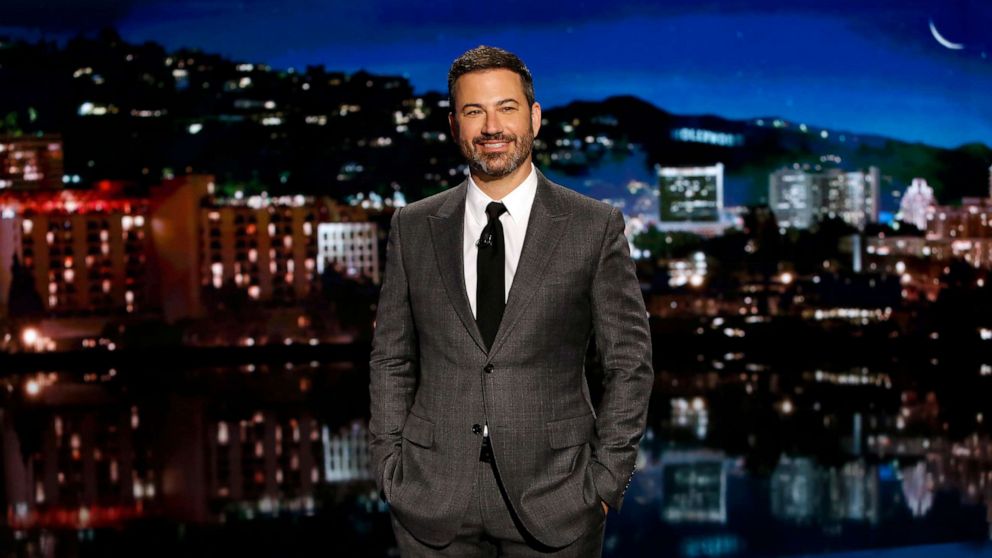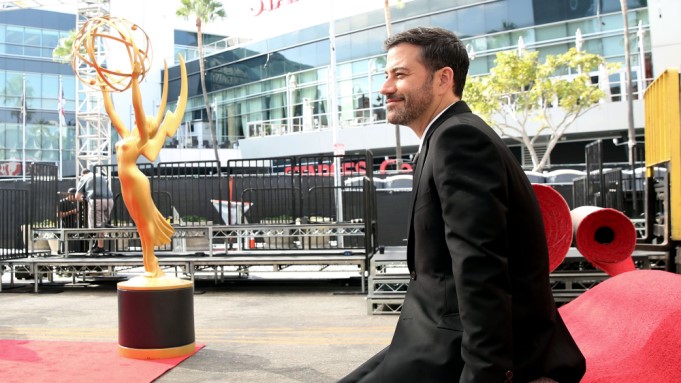GOOD MORNING AMERICA:

Emmys 2020 Plans Revealed: Inside the Daring Idea to Broadcast Live From 140 Locations (EXCLUSIVE)
Variety: Aug 24, 2020 11:00am PT By Michael Schneider

With less than a month to go before the Primetime Emmys, the telecast’s producers are still building the show and figuring out how to make it as live — and safe — as possible. And at the same time, they promise that they’re not aiming to do “Emmys Light.”
“We shouldn’t lose sight that Emmys are prestigious awards, and we’re not giving them out for fun, we’re giving them out to reflect excellence,” said Done+Dusted president Ian Stewart, whose company is involved in the production of the show for a third year in a row. “However, apart from that, it’s all available to be blown up, quite frankly. Because awards have been the same way for many, many years.”
Variety recently spoke with 72nd Emmy Awards executive producers Reginald Hudlin and Stewart, who revealed for the first time how this year’s ceremony will look. Host Jimmy Kimmel will anchor the Emmys from a stage in the Staples Center, but there will be no audience and no red carpet.
“Jimmy loves to work live, and we love to work live,” Hudlin said. “This is a show that will still very much be, whenever and however possible, a live show. There’s a lot of challenges that come with doing a live show in a COVID environment. But we’re not running from those problems, we’re embracing them.”
The Emmys normally take place across the street at the Microsoft Theatre, but Staples (like the Microsoft, owned by AEG) was chosen because of the facility’s tremendous size.
“One is that it’s so large that the crew can work safely under COVID-safe protocols and be at the appropriate distance from each other,” Hudlin said. “Because obviously the most important thing is safety first. The second part is, this show will need an unbelievable number of wiring connections in and out, because the nominees are not going to be there. So we’re going to take cameras to where they are. And the number of feeds that that requires is so massive that we need a facility like the Staples Center, which is used to having that much signal from reporters covering sports to handle the kind of in and outputs that it requires.”
The producers require that capacity because of an ambitious plan they’ve crafted to have professional cameras and, if possible, camera operators stationed where every nominee is located. (For programs, one of the nominated producers will be chosen to serve as the show’s on-camera representative.) That’s as many as 140 live feeds coming into the control room at Staples.
“This will all depend on the comfort level of the people at the other end, but we’ve got to go and find them,” Stewart said. “They might be at home, they might be in the garden, might be in a hotel, they might be standing on the side of the street. It doesn’t really matter, wherever they feel comfortable. But we want to bring every nominee that we can logistically, live into the show.”
In comparison, the five-night Creative Arts Emmys (Sept. 14-17 and 19) producers are asking all nominees to send over a pre-taped acceptance speech, but only the winner’s thanks will air. In this case, Hudlin, Stewart and team want to be live as much as possible, adding an extra layer of technical difficulty. The producers said they’re prepared to address nominees’ different concerns, particularly when it comes to sending over crew. In some cases, they may agree to have a family member in a nominee’s COVID bubble to operate the broadcast camera. The goal is to avoid using platforms like Skype, Facetime or Zoom on their laptop or phones.
“We’re not trying to make the Zoomies, we’re trying to make the Emmys,” Stewart said. “So one of the things we are trying to do is get the highest-end kit to wherever that person is on whatever level of comfort they have. The best thing for us is to have very high-end cameras, with a person operating them in somebody’s house or wherever they are. That’s our starting point.”
But the producers are aware that some nominees may be in a strict quarantine as they prepare to head into production.
“There will be people who logistically or whatever, we can’t do this,” Stewart said. “We’ll come up with other solutions. But our start point is nothing technology-wise that people have seen before.”
Then there are other challenges that they’re still working through, such as whether winners will get a chance to hold an Emmy while giving their live acceptance speech. (One idea, of having cars race to winners’ homes to slide them an Emmy statue, was ultimately nixed.)
“There are people who are nominated who live in Los Angeles, who live in London, who live in Berlin and Tel Aviv, so we’re looking through all those all those questions and all those challenges and trying to figure it out,” Hudlin said. “But again, that gets into what people’s comfort level is. Do you want someone ringing your doorbell? We’re coming up with a lot of interesting possible solutions. And one of the things that we’re working through in terms of the show is that everything doesn’t have to be the same. We want to have a lot of variation and experimentation within the show. Once you say the world is your studio, then you can do some inventive things.”
Stewart said that variation also extends to the nominees who will be seen on camera: Some may be dressed in their designer best, while others may sport pajamas. “If you want to be in your sweats on your sofa that’s also fine,” he said. “It will be much more casual, much more fun, as we’re more in it together. It will go where it goes. We hope really well, but I can’t sit here and say that it’s going to go 100% perfectly because no one’s ever done it before.”
Added Hudlin: “So often when people win they award, they dedicate it to their kids. Well, your kids can be right there with you. Maybe you’re accepting the award from their bedroom. This is a chance to reinvent every aspect of it. We really want people to think about that.”
Among other elements for the show, the producers are looking at having some presenters at the Staples Center, while others will be remote. They’re also looking at potential musical numbers by major artists, and how to replace the usual orchestra that plays people on and off stage. And they plan to give viewers a glimpse behind the scenes at how they’re pulling off a live event in such an unusual way.
“As you watch the show, you’ll see what we’re doing and why we’re doing it,” Hudlin said. “We think that will actually be part of the excitement of watching what we’re doing. We’re going to be very transparent about what’s happening and why.”
Stewart said this year’s ceremony would focus on the fact that television has been a bit of a lifeline and diversion for people stuck at home during these quarantine times.
“Every person has sat down and sought comfort with their TV,” Stewart said. “So we want to try to reflect that, celebrate that, and the fact that we’re all in this together now.
Of course, Hudlin and Stewart said they’re also leaning on host and fellow executive producer Kimmel, a live TV veteran who has spent a good chunk of this year figuring out how to do a virtual show in these times. “I’ve done live all my life but I don’t have a tenth of his instinct for it,” Stewart said.
An element that the producers nixed early on was the idea of having any sort of actual audience in the Staples Center. “It’s still too dangerous, especially in Los Angeles at the moment, to put people in close proximity,” Stewart said. Added Hudlin: “Award shows are typically designed for theatrical setting, a bunch of seats and people watching and you’re performing to that audience. Once you remove the audience, that frees up how you think about how you’re showing everything.”
The decision to cancel the red carpet, and the traditional arrivals pre-show, came after they nixed bringing nominees to the Staples Center. After early conversations about how to reinvent the red carpet as a virtual experience, the producers decided they should just focus on the main ceremony instead. “Ultimately it felt like we should stick to what’s on our plate and get that done,” Hudlin said.
And that includes figuring out the complicated logistics to having a camera on 140 different nominees across the world. “Normally, you’re concentrating on what’s going out of your venue. Here, before we even can make something go out, we’ve got to deal with 120-140 things coming in,” Stewart said. “And also there’s human beings at the end of those feeds. We don’t want people on edge, we want them feeling comfortable to come in and have fun.”
The producers have already sent one letter to nominees hinting at how the Emmys might go live from their house, and Hudlin said much more detailed information would be sent out shortly.
Hudlin and Stewart said the producers have received full support from the Television Academy and ABC as they set out to create this new version of an Emmy broadcast. But Stewart does have one gripe: He was hoping the awards show’s accountants might bend the rules and give the producers an early peek at the winners to plan accordingly.
“That was shut down,” he said. “We thought maybe this year was an extraordinary situation, but unfortunately there’s no leeway on that. We will find out when everyone else finds out. Which is the right way to do it, it’s just annoying.”
Kimmel, Hudlin and Stewart will be joined by Done+Dusted’s Guy Carrington and David Jammy as executive producers, while the company’s Hamish Hamilton is directing. The TV Academy made history this year by tapping Hudlin, whose credits include the 2016 Oscars, as the first-ever Black executive producer of the Emmys.
“It was a no brainer,” Stewart said. “We need every voice in this room in this time. I’m a pale male stale guy, I’m not speaking for everybody in America and we want to make sure that we are. You always want to build a team that has everything in it, and Reggie brings us so many bloody skills that we don’t have. And also, we get to steal his ideas, which was really cool for the future.”
Hudlin made headlines just this weekend by revealing at DC FanDome that he was helping revive the Milestone Comics imprint and that a “Static Shock” movie is in the works. Hudlin, who earned an Emmy nomination for producing the Oscars, and whose awards show credits also include executive producing the NAACP Image Awards for nearly a decade, said he relished the challenge of figuring out this year’s Emmy telecast.
“We start every day by reinventing the show,” Hudlin says. “And then by the end of the day we rip it all down and then we start again the next day. I sound like I’m joking, but I’m kind of not. You may be wondering, ‘Reggie, aren’t you’re very close to show time to not be certain?’ Yes, we know!”
